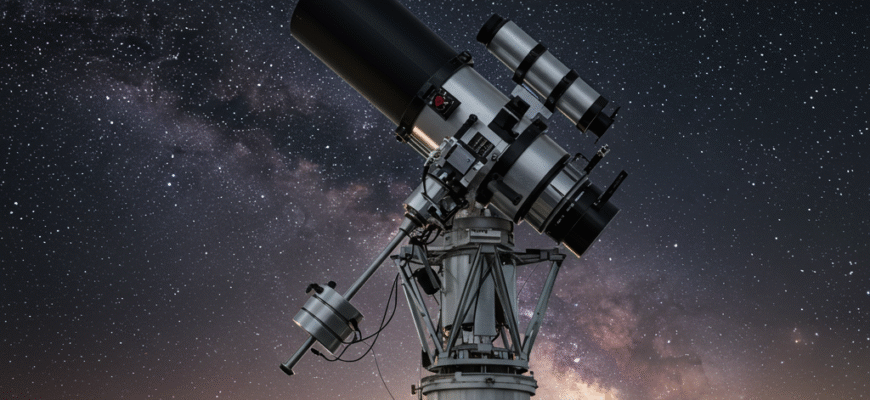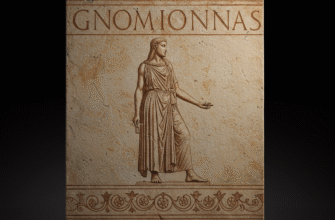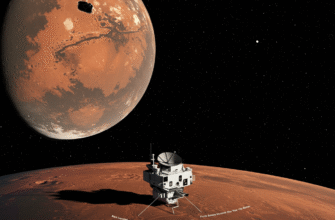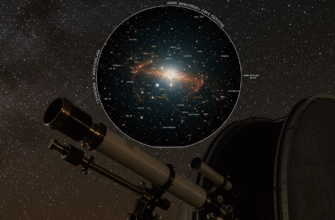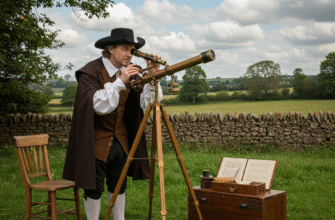Gazing up at the night sky, one might feel an overwhelming sense of immensity. For astronomers, this vastness presents both a tantalizing opportunity and a formidable challenge. How does one even begin to chart such an expanse, to capture the fleeting events and faint whispers from distant cosmic shores? Traditional telescopes, designed for deep, narrow views, are like peering through a keyhole. To get the bigger picture, a different kind of instrument was needed, one that could gulp down huge portions of the sky in a single exposure. This is where the remarkable Schmidt telescope stepped onto the stage, revolutionizing astronomical surveys.
The genius of the Schmidt telescope, conceived by Bernhard Schmidt in the 1930s, lies in its unique optical design. Unlike conventional reflector telescopes that often struggle with off-axis aberrations when trying to achieve wide fields, the Schmidt employs a spherical primary mirror. While a sphere is easier to manufacture, it inherently suffers from spherical aberration, meaning light rays don’t all focus at the same point. Schmidt’s masterstroke was the introduction of a thin, aspheric corrector plate placed at the center of curvature of the primary mirror. This lens, with its complex curves, pre-distorts the incoming light to perfectly counteract the primary mirror’s aberration, resulting in sharp images over an exceptionally wide field of view.
The Schmidt telescope’s design, featuring a spherical primary mirror and an aspheric corrector lens, is specifically engineered to minimize optical aberrations like coma and astigmatism across a large angular area. This allows it to capture sharp images of extensive regions of the sky in a single observation. Consequently, these instruments are exceptionally well-suited for comprehensive astronomical surveys.
Pioneers of the Panoramic Sky
The power of this design was not lost on the astronomical community. Almost immediately, plans were laid for larger Schmidt telescopes. Perhaps the most iconic of these early giants was the 48-inch (1.2-meter) Samuel Oschin Schmidt Telescope at Palomar Observatory. Commissioned in 1948, this instrument embarked on a monumental task: the first Palomar Observatory Sky Survey (POSS I). Over seven years, it meticulously photographed the entire northern sky visible from Palomar, producing a celestial atlas on nearly two thousand photographic plates. This survey became an invaluable resource for generations of astronomers, a foundational dataset upon which countless discoveries were built.
The success of POSS I spurred further endeavors. In the Southern Hemisphere, the UK Schmidt Telescope (UKST) at Siding Spring Observatory in Australia undertook a similar comprehensive survey of the southern skies, complementing the Palomar effort. Together, these surveys provided the first truly deep, wide-angle photographic map of nearly the entire celestial sphere. The data was so rich that a second Palomar survey, POSS II, was conducted in the 1980s and 1990s using improved photographic emulsions and filters, pushing deeper and capturing finer details.
From Glass Plates to Digital Pixels
For much of their history, Schmidt telescopes relied on large photographic glass plates. These plates, often measuring 14×14 inches, were carefully curved to match the focal surface of the telescope, ensuring sharpness across the entire wide field. Developing these plates was an art form in itself, requiring meticulous chemical processing. The resulting archives of sky images were, and in many cases still are, treasure troves.
Astronomers would painstakingly scan these plates by eye using microscopes or later, with specialized measuring machines like the Automatic Plate Measuring (APM) machine in Cambridge or the SuperCOSMOS at Edinburgh. These machines could digitize the plates, allowing for automated detection of objects and precise measurements of their brightness and position. This was a crucial step in extracting the scientific gold from the vast datasets.
The advent of large-format Charge-Coupled Devices (CCDs) in the late 20th century began to transform the field. While early CCDs were small, technological advancements eventually led to mosaics of CCDs that could cover fields of view comparable to photographic plates, but with much higher quantum efficiency (meaning they detected a far greater percentage of incoming photons) and a linear response. This digital revolution allowed for more sensitive surveys and immediate data access, though the sheer volume of data from digital sky surveys presented its own set of computational challenges.
Unveiling the Hidden Cosmos
The wide-angle capability of Schmidt telescopes made them ideal for discovering objects that are rare, faint, or transient. Their contributions are manifold:
- Dwarf Galaxies: Many of the Milky Way’s faint satellite dwarf galaxies, crucial for understanding galaxy formation and dark matter, were first identified on Schmidt plates. Their low surface brightness made them invisible to narrower-field surveys.
- Quasars: The earliest systematic searches for quasars, incredibly luminous and distant active galactic nuclei, relied heavily on Schmidt surveys. Their distinctive colors or spectra on objective-prism plates (where a prism spread starlight into mini-spectra) allowed them to be picked out.
- Supernovae and their Remnants: While individual supernova discoveries often come from dedicated search programs, Schmidt surveys have been instrumental in finding ancient supernova remnants – the expanding shells of gas from exploded stars – by imaging their faint, diffuse emission.
- Asteroids and Comets: Schmidt telescopes have been prolific discoverers of Solar System bodies. Their ability to cover large sky areas quickly is perfect for spotting moving objects against the backdrop of stars. This includes numerous Near-Earth Objects (NEOs), vital for planetary defense studies.
- Large-Scale Structure: By mapping the distribution of thousands upon thousands of galaxies over vast areas, Schmidt surveys provided early crucial data for understanding the cosmic web – the filamentary structure of how galaxies are arranged in the Universe.
The serendipitous nature of discovery is also a hallmark of Schmidt surveys. By capturing everything within their broad gaze, they often revealed unexpected phenomena or objects that weren’t the primary target of the observation, leading to new avenues of research.
Enduring Influence in the Digital Age
While new generations of survey telescopes, often with more complex optical designs to achieve even wider fields or greater depths (like Pan-STARRS or the Vera C. Rubin Observatory’s Simonyi Survey Telescope), have come online, the Schmidt design hasn’t entirely faded into history. Some original Schmidt telescopes have been upgraded with modern CCD cameras and continue to perform valuable survey work, often focusing on specific niches like rapid cadence observations or follow-up of transient events discovered by other facilities.
For example, the Zwicky Transient Facility (ZTF) utilizes an upgraded camera on the Palomar 48-inch Schmidt, scanning the entire Northern Sky every two nights to find anything that changes or moves. This is a direct continuation of the Schmidt legacy, adapted for the era of “time-domain astronomy.”
More broadly, the fundamental concept pioneered by Schmidt telescopes – the importance of wide-field imaging for statistical studies, for discovering rare phenomena, and for creating comprehensive celestial maps – has profoundly shaped the direction of observational astronomy. The challenges of handling and analyzing the vast datasets produced by Schmidt surveys also spurred developments in automated data processing, astronomical databases, and computational techniques that are now standard practice.
Navigating Limitations and Looking Forward
Of course, Schmidt telescopes, particularly ground-based ones, face the same challenges as other optical observatories. Atmospheric turbulence blurs images, limiting resolution, and increasing light pollution from urban development threatens the darkness of observatory sites. The photographic era had its own issues with non-linear responses of emulsions and the painstaking manual labor involved.
Despite these limitations, the Schmidt telescope’s contribution to astronomy is undeniable. Its elegant solution to the problem of wide-angle imaging opened up the sky in an unprecedented way. From charting the nearby cosmos to finding the most distant quasars, from tracking asteroids to mapping the large-scale structure of the universe, Schmidt telescopes have provided the foundational observations for much of what we know about the universe today. They were the workhorses that painted the broad strokes of our cosmic understanding, creating invaluable atlases that continue to guide astronomers in the era of even larger and more sophisticated survey machines.
Their legacy is not just in the archives of photographic plates or digital data, but in the very philosophy of modern astronomical surveys: to cast a wide net and see what wonders the universe reveals.

